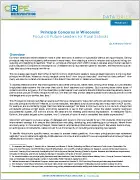To address important questions about their principal workforce, states need to build detailed longitudinal data systems like those they use to track teachers and students. But in some places those systems are along way off. In the meantime, administrative data can provide a basic picture to help prompt questions and discussions about school leadership needs. This brief uses publicly available administrative staffing and student achievement data from the Wisconsin Department of Public Instruction to answer these questions: How many principals are near retirement eligibility? How is eligibility distributed across schools and locations? How are experienced and new principals distributed across school types? The findings show that over 70% of Wisconsin’s principals will still be on the job in five years, and that small, rural districts are most affected by upcoming retirements. The analysis also shows that there is an even distribution of principal experience across school types, with no pattern linking principals’ total years of experience and the percentage of economically disadvantaged students in the schools they lead. The brief recommends a dual strategy for the state: focus on supports for current principals, and on recruitment and development of leaders for rural schools. This is the third in a series of state-specific briefs. Earlier briefs analyzed the principal workforce in Iowa and Indiana. A related report, Principal Concerns: Leadership Data and Strategies for States, provides a guide to help policymakers diagnose their principal workforce needs and outlines a number of actions states can take, such as providing principals with more autonomy and making mentors out of high-performing principals.




